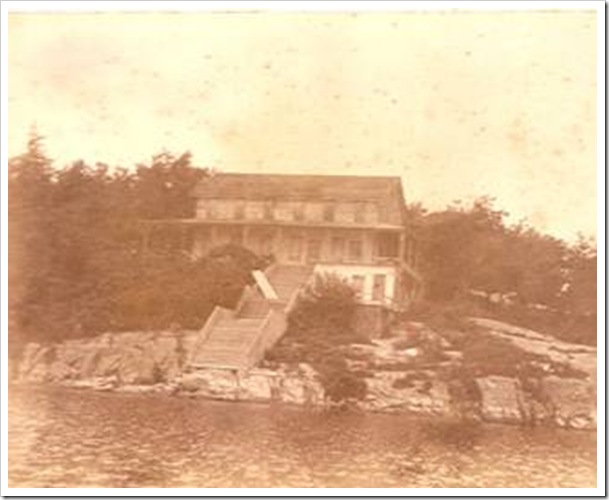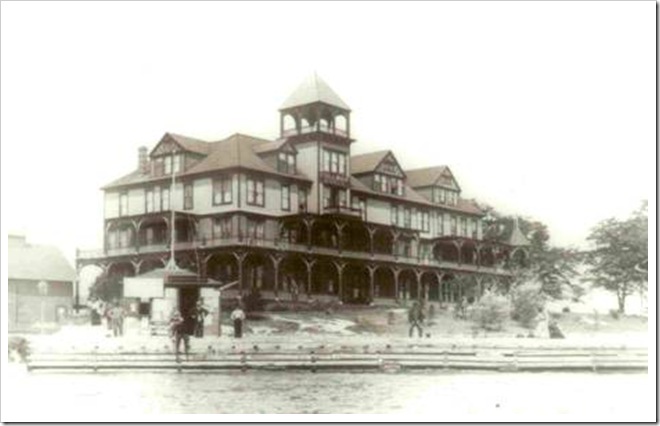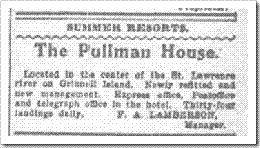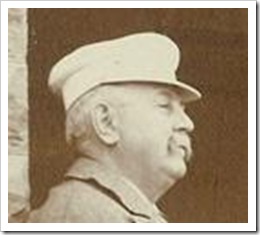Rexford M. Ennis is the author of several dissertations on Thousand Islands history; often presented to an appreciative audience at the Thousand Islands Museum, in Clayton or the Grindstone Island School House on Grindstone Island. For several years Rex has also been compiling research for a biography of Charles Goodwin Emery, builder of Calumet Castle opposite Clayton, NY. Thousand Islands Life Magazine is pleased to present this historic review of those hotels built upon islands near Clayton. Many of the early hotel guests were enchanted with the region and they purchased island lots or individual islands and built summer homes. In many cases, these hotels were the catalyst for what we now call Thousand Islands life.
Introduction
Clayton’s Gilded Age began in 1880 and lasted until the end of World War I. The railroad terminus at the river’s edge made Clayton the ideal "jumping-off point" for travel to the Thousand Islands, especially to its Grand Hotels. The Town of Clayton serviced five island hotels for many years:
Cliff House 1876-1878, two years
Murray Hill Hotel (1895-1915), 20 years
Hub House (1877-1883), six years
Pullman House (1890-1904), four years
Round Island House (later New Frontenac Hotel ) (1877-1911), 34 years

© Thousand Islands Museum Collection, Clayton, NY. All rights reserved.
Cliff House-Clayton’s Haunted Hotel
The Cliff House's name was derived from its perch high on one of Murray’s Island cliffs. It was probably constructed in 1877 at a reported cost of $3,000 ($4,861,000 in 2007 dollars) and was owned by Mr. Elsiha Garrison of Syracuse. Many legends surround the Cliff House, including a man having been killed there in a gaming dispute which gave it the reputation of being haunted.
In 1881 a disaster associated with the Cliff House did occur. Frank (caretaker at the Hub House) Cuppernull ’s wife and two children, along with Charles (caretaker at the Cliff House) Wilson’s wife and two children, drowned in Eel Bay on their way to Gananoque. The cause of the accident remains unknown.
The Garrisons had two good seasons at the Cliff House, until the Hub House opened. At the end of their second season, the Garrisons packed up, locked up, and left the property at the mercy of vandals and the elements. Neighbors, in an effort to protect what valuables they could, began to remove items for safe keeping and gradually the building was stripped. Except for one item, a very large stove, which could not be removed from the kitchen. The building became a popular destination for couples looking for some privacy. Colonel Watson, a nearby resident, once put a sheet over his head and scared a group of young couples, who ran down to the landing where they jumped in the river. This episode added to stories of ghosts haunting the Cliff House.
Some of the more ghoulish stories included one of babies’ bodies being thrown in a well near the property by a woman who operated a “baby farm.” Another involves a black man who went out drinking and ended up seeking a bed in the deserted hotel. During the night a pair of bony hands grabbed his neck and started to choke him. He struggled to escape his attacker, fell in a pile of leaves and awoke in the morning. The doubters insisted he had suffered from an attack of delirium tremens and in his agony clutched his own throat.” ( a precis of an article in the Syracuse Sunday Herald, June 28, 1896)
The Murray Hill

Postcard from the © Thousand Islands Museum Collection, Clayton, NY. All rights reserved.
Constructed during the summer of 1895, the Murray Hill Hotel was 300 feet long, four stories high, and had an advertised capacity of 500 guests. Construction cost was $100,000 ($88,490,000 in 2007 dollars). This post card shows the wraparound porch which was 520 feet long and 18 feet wide. Rates at the hotel were $3-$4 per day and $15-$28 per week American Plan (meals included). The hotel was owned by Amasa Corbin Jr. of Gouverneur and Capt. James “Jack” Taylor. Taylor purchased what was then called Hemlock Island for $100 in cash and a second-hand shot-gun.
|
“The hotel has had a different lessee nearly every year, and suffered accordingly, as it has had some ‘bad ones,’ one of whom is now ‘doing time’ in California” “A strange feature is that it is entirely free from flies and mosquitoes, a stiff, cool breeze always sweeping over it.” Hotel World, 28 July 1902.
The hotel was very modern, equipped with elevators, billiard rooms, sitting-rooms, private and public baths, electric lights, and a fire alarm system.
The hotel was sold to the Republic Trust Company of Dallas, Texas, in 1912, for $120,000. It closed in August 1915. In 1942 the derelict hotel was torn down by the Murray Isle Improvement Association, which had maintained the dock and post office in front of the hotel.
|

Postcard from © Thousand Islands Museum collection, Clayton NY
|

© Thousand Islands Museum Collection, Clayton, NY. All rights reserved.
The Hub House was one of the most popular hotels in the islands during its short life. It was constructed in 1877-8 by George Best of Oswego, NY. It had an advertised capacity of 200 guests and covered three quarters of the island; it appears to be floating in many photos. As the Thousand Islands Park on nearby Wellesley Island was dry (no alcohol) the bar at the Hub House became extremely popular. So much so, that in the 1882 season the Thousand Islands Park board voted to terminate the ferry service between the Park and the Hub House provided by the Steamer E. A. Van Horne.
It just happened that the Van Horne was owned by George Best! It was announced on 10 October 1883 that the Hub House would be raised three feet and new docks built; however, it burned on December 3, 1883. The hotel was insured for $40,000 and the estimated loss was $25,000.
A Steamer Story
In July 1879, a party of one hundred from Syracuse, arrived in Cape Vincent by train at about 8:30 in the evening. They boarded the steamer Island Wanderer and started for Alexandria Bay. The trip would be an adventure; about a mile out of the Cape, the Wanderer had to return to shore and repair a blown check valve. A half-an-hour later the party was again on its way to Alex Bay. This time a packing on a pump failed and again the steamer returned to the Cape for repairs. An hour later the Wanderer was off again, and at about eleven o’clock it was opposite the Hub House. The hotel was putting on a display of fireworks and colored lights. Several of the passengers convinced a reluctant captain to land at the Hub House. The steamer was at Thousand Islands Park and changed course for the Hub House. A surprise to no one who knows the waters off TI Park, in less than a minute after changing course, the steamer was on a shoal. Engines were reversed in attempt to get off the shoal to no avail. The passengers were terrified. “Among the passengers were two young ladies who had up to this time been the life of the party. In the face of danger their excessive joy was turned into the most utter despair, and with pale, upturned faces they entreated to be taken ashore.” With an escort, they got into a skiff and attempted to row ashore to the Hub House. The steamer “Farrington,” coming to the rescue of the Wanderer, struck the skiff amid ship and the passengers were thrown out. All were eventually rescued, however, it should “teach the lesson that the only safe way to navigate the river at night is to stick to the main channel.” Syracuse Daily Standard, 20 July 1879.
Pullman House

Photo courtesy © Corbin’s River Heritage. All rights reserved.
Pullman Island did not exist until a storm washed out the connection, which had made it part of Grenell Island. Later, a bridge would be built to connect them again. Samuel B. Grenell was the first to construct a “hotel’ on the spot where the Pullman House was constructed during the winter of 1889-90. The previous Grenell House, operated by Sam Grenell, was a small structure and was noted as a watering hole for patrons from “dry” Thousand Islands Park. Sam Grenell was a bit of a character and during the Civil War claimed that Grenell, including what was to become Pullman Island,  was in Canada and not subject to US and New York liquor license laws. As the Federal government was engaged in the War, no attempt was made to enforce sovereignty over Grenell. The Canadian Government didn’t know that Grenell was supposed to be Canadian, so it did nothing. The result was that Sam Grenell operated as virtually an independent nation. However, Sam made one big mistake. He went to Clayton to vote in the 1864 election and questions were asked about how he could vote if he was Canadian. Needless to say, Sam’s independence came to an end.
was in Canada and not subject to US and New York liquor license laws. As the Federal government was engaged in the War, no attempt was made to enforce sovereignty over Grenell. The Canadian Government didn’t know that Grenell was supposed to be Canadian, so it did nothing. The result was that Sam Grenell operated as virtually an independent nation. However, Sam made one big mistake. He went to Clayton to vote in the 1864 election and questions were asked about how he could vote if he was Canadian. Needless to say, Sam’s independence came to an end.
In 1889, J. I. Sayles and George C. Bedell, both of Rome, NY, purchased the newly formed island and named it Pullman, after George M. Pullman of Pullman Car fame. The Pullman House was three stories high, 85 X 50 feet, with large verandas on two stories. The hotel sported a boathouse in the basement, complete with eight Joseph Leyare skiffs for the use of the guests, along with a laundry and barber shop. Although a small island, the hotel was positioned to allow for a lawn tennis court and croquet grounds. First floor public rooms included: 20 X 25 foot drawing room, 40 X25 foot dining room, both with brick fireplaces, an office, reading and smoking room, barroom, and cloakroom. Also on the first floor were private offices, kitchen, and a storeroom. The second and third floors contained 27 guest rooms each; the guest rooms all had an excellent view of the river. Each room was equipped with a fire escape.
Bath rooms with hot and cold water and toilets were located on each floor. The building was designed by Architect George Schillinger Jr. of Rome and constructed by D. D. Butts of Clayton, at a cost of $19,000 ($17,399,000 in 2007).
The hotel got into some trouble in 1902 when its liquor license was revoked for operating an illegal slot machine; there was also a $10 fine. The hotel had a water toboggan slide with bath house underneath. It was called the Pullman House Natatorium. The hotel burned on 10 September 1904; no one was injured.
Round Island House
The New Frontenac was originally the Round Island House. A group of Baptists from Watertown and Syracuse conceived of a park similar to the Methodist’s Thousand Islands Park. Round Island was purchased on 22 August 1878, by the Round Island Corporation from Daniel & Jane Porter, Clayton, for $9,000. A park was laid out with around 400 lots to be leased for summer residents. The Round Island House Hotel was constructed. A year later the Corporation dropped any association with the Baptist denomination and became a secular park. The hotel operated unsuccessfully until 1888, when Jacob Hayes and Hubert Van Wagenen and others leased the hotel and remodeled it.

Photo Courtesy © Corbin’s River Heritage. All rights reserved.
The Hotel Frontenac
The leasers began extensive renovations to the Round Island House. They added large wings and a building for bowling and billiards. The new building would exceed 400 ft in length. An important change was the name; the Round Island House became the Hotel Frontenac. This group continued to operate the remodeled hotel until 1897, when due mostly to absentee management and a depression, the Round Island Corporation defaulted on its mortgage. The Island was sold to Jacob Hayes, the mortgage holder, at a Sheriff’s sale on the steps of the hotel on 21 August 1897 for $37,000.
The New Frontenac

Jacob Hayes sold the Hotel Frontenac and Round Island to the Round Island Company in 1898. The company’s largest stockholder was Charles G. Emery of Pasadena, CA and Calumet Island. Emery started with a new round of remodeling and soon the Hotel Frontenac started its third stage as the New Frontenac. Emery’s concept was to make the New Frontenac not only the best hotel in the Thousand Islands, but in fact a world class hotel. In an unusual move, much of the old Hotel Frontenac was retained and reconstructed. 
A new wing was added to the back containing the dining room/ball room and a kitchen. The kitchen was in a brick structure separated by a brick firewall to prevent a kitchen fire from spreading to the whole hotel. Despite this and other fire prevention ideas incorporated into the structure, it burned on 23 August 1911. A local fishing guide was killed when he entered the burning hotel on a rescue mission. The fire started in the Men’s Dormitory, which was located behind the west end of the hotel. The fire started in room 117 by an improperly discarded cigarette. This was ironic as Charles G. Emery was one of the founders of the American Tobacco Company and the inventor of a cigarette making machine.
Famous guests at the New Frontenac included the Maharaja of Baroda, William Howard Taft, Howard Gould (son of Jay Gould), and Thomas Edison.
By Rexford M. Ennis, Grindstone Island RexEnnis@thousandislandlife.com
© Copyright Rexford M. Ennis 2007, All Rights Reserved
Well known local historian, Rex Ennis first presented this material as part of a fascinating history boat cruise in August 2008 on board Clayton’s Island Girl. The History Tour was sponsored by the Thousand Islands Museum.